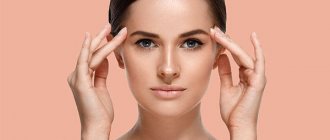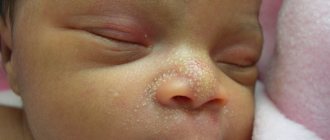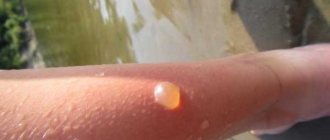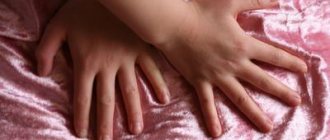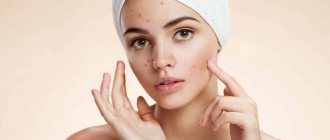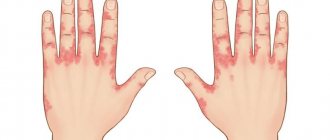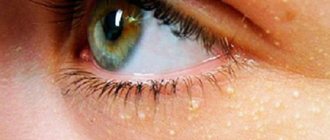Causes of rashes on the face of a newborn
As all experts note, pimples on a newborn’s face appear in almost every second child. They are not dangerous and do not in any way affect the development of the baby. True, they can cause anxiety in the baby, because many of the rashes are itchy. The causes are varied:
- Hormonal fluctuations. After birth, in the first six months, the baby’s hormonal levels are just developing and are often subject to fluctuations. This causes a rash on the face of a newborn. It can appear in the form of red dots with white liquid inside, which are concentrated on the cheeks and forehead of the baby. Usually such rashes go away within a month. These rashes on the face of a newborn are not dangerous, but if there are a lot of them, then you should consult a specialist to avoid dermatitis or suppuration.
- Allergic reactions . Allergy in a newborn on the face (crimson-scarlet pimples on the cheeks, around the mouth, on the forehead) is a consequence of the mother’s poor nutrition or an incorrectly selected formula for artificial feeding. If the baby is breastfed, then the mother needs to carefully reconsider her diet. The most allergenic foods are those that contain red pigment - tomatoes, red peppers, etc. Cow's milk also has a negative effect on a child's health, even if the mother drinks it. Therefore, analyze your nutrition and monitor it. If a newborn's facial allergies do not go away for a long time or even get worse, contact a nurse or a breastfeeding specialist. They will help you find the root of the problem.
- Failure to comply with hygiene rules. It appears as small red bubbles. Heat rash on the face of a newborn occurs if the baby is wrapped up very tightly and he constantly sweats. Many mothers do not realize that the baby’s thermoregulation has not yet been formed, and he does not sense temperature as much as adults. In general, babies tolerate cold better than heat. So you shouldn’t put a lot of clothes on your child if you think it’s cool. Another cause of prickly heat is poor hygiene. After bathing every night, you need to thoroughly dry the baby and lubricate the skin with baby cream. Don't neglect air baths either.
- Infections. A rash on the face of a newborn may be a symptom of an infectious disease. It may look like this: reddish-pink, if we are talking about baby roseola; in the form of a bubble with clear liquid, if it is chickenpox; papular if measles infection occurs. Typically, an infectious rash is accompanied by a fever, and the child is restless.
Top
Infectious rash
Rashes as a result of the development of an infectious disease, as a rule, affect older children: from 1 year to 5 years. The most popular types of infectious diseases:
- Chickenpox is typical for kindergarten-age children. The method of transmission of infection is airborne droplets. It appears in the form of itchy blisters with liquid inside, covering the entire body, including the scalp and mucous membranes. The temperature rises, the blisters burst, the wounds become crusty and heal within a week.
- Roseola (sudden exanthema) affects mainly one-year-old children. The temperature lasts for three days. After it decreases to normal levels, a pink rash appears, which disappears gradually over 5 days. In parallel, the following symptoms are observed: general malaise, red throat, runny nose, swelling of the eyes, enlarged lymph nodes, convulsions are possible.
- Rubella is accompanied by the appearance of a red, large or small rash after several days of elevated body temperature. Characteristic signs are enlarged lymph nodes and a sore throat.
- Children aged 3 to 5 years are susceptible to scarlet fever. Bright red pimples appear on the face, then spread throughout the body, the temperature rises, the child becomes generally unwell, and a severe sore throat appears.
- Measles is one of the most serious and dangerous infectious diseases. Pink flat spots appear on the face, later merge into large spots, gradually descending to the neck and chest area. After the spots disappear, dryness and flaking remain in their place. This goes away within a week. Associated symptoms: fever, temperature up to 40 degrees, upset stomach, runny nose, sore throat, dry cough, headaches. If left untreated, measles causes life-threatening complications such as ear infections, pneumonia and inflammation of the brain. Mass vaccination of children plays a huge role in reducing the incidence of measles.
Treatment of infectious diseases, in the absence of complications, is carried out at home, but under the close supervision of a doctor. It is categorically unacceptable to independently treat a child for rashes of this nature, since if the diagnosis is incorrect, the medications will cause irreparable harm to the baby’s health. In addition, only a pediatrician will be able to establish the reasons for what is happening, select the right drug and prescribe the optimal dosage for weight and health status.
Help with rashes on the face of a newborn
Demodicosis usually has classic symptoms. Subcutaneous mite on the face You should not immediately resort to the help of various powders and ointments; usually acne on the face of a newborn, if it is not infectious or allergic in nature, goes away on its own. But for peace of mind, it is better to consult a doctor.
General treatment recommendations:
- bathe your baby in a decoction of herbs, chamomile, and sage. Wash the newborn’s face with this water,
- You can make a bath for a newborn with a weak solution of potassium permanganate. Be careful not to burn delicate skin.
- moisturize your facial skin with special hypoallergenic baby products,
- After feeding, wipe the skin around your mouth from milk residues,
- Ventilate the room often and monitor the temperature in it. It wouldn't hurt to hang up a thermometer. Comfortable temperature for a newborn is 18-21 degrees,
- acne on a newborn's face will go away on its own if you stop wrapping your baby when you go for a walk or at night,
- trim your baby’s nails so that he can’t scratch the pimple and cause an infection,
- Wash bed linen with baby powder.
Top
Review of infectious factors for the formation of rashes on the face
Spots and pimples are symptoms of such classic childhood diseases as chickenpox, measles, scarlet fever. The skin's reaction to the infection leads to the formation of a rash on the child's head, as well as on other parts of the body. Viruses are transmitted through droplets of saliva during sneezing and coughing, and through direct contact with infected skin and things. However, not every infected child develops a rash.
Chickenpox
The chickenpox virus is transmitted by sneezing and coughing in air currents over long distances. This is where the name “chickenpox” comes from. Children aged 2 to 5 years are affected; infants and primary school students can become infected. After about two weeks, a fever begins, itchy blisters appear on the face and neck, which spread to the torso, arms and legs. Sometimes the virus infects the mucous membranes of the mouth, eyes, throat and genitals. The blisters should be treated with antiseptics for one or two weeks. Lotions with infusions of chamomile or other anti-inflammatory herbs will help relieve itching.
Symptoms of sudden exanthema (three-day fever)
The disease most often occurs in children between 6–12 months of age, but a child can become ill as early as 2 years of age. The high temperature lasts for three days at about 40°C, then quickly decreases. A pale red, patchy rash forms on the head and torso, after 2 days the symptoms subside. The incubation period between infection and the onset of the disease is 5–15 days.
Erythema infectiosum
The duration of the incubation period is 3–5 days. Small, then large spots appear on the child’s cheeks, gradually taking on the shape of a butterfly. The disease is accompanied by sore throat, fever, and loss of appetite. The rash spreads to the trunk and limbs. The child is given antipyretics and bed rest in the first days.
Measles is a viral disease with flu-like symptoms
The child is feverish and exhibits cold symptoms. A rash, typical of a viral infection, appears after 4 days and is accompanied by itching. The rash first appears on the face and neck, later on the torso. Temperatures can rise to 40°C. The child becomes weaker during illness and needs more rest. Measles is highly contagious and the infection is transmitted through the air through droplets of saliva. The incubation period is about 3 weeks.
Thanks to routine vaccination, measles is considered a rare disease.
Rubella is a dangerous infection for an unborn baby
A viral disease manifests itself in children with enlarged cervical lymph nodes. After one or two days, a light red rash appears behind the ears and spreads to the face and throughout the body. The disease is accompanied by fever and pain, but not in all cases. The spots disappear 1–3 days after formation.
What not to do if a newborn has a rash on his face
Often mothers, having noticed pimples on the face of a newborn, try to treat the child themselves, but this only harms and provokes the appearance of rashes.
- Do not overdry the baby's skin. This means that the use of lotions and “drinkers” that contain alcohol is undesirable.
- Fatty creams and ointments aggravate the problem. In a fatty environment, bacteria multiply faster, so inflammation is possible.
- Do not use antiallergy medications and antibiotics on your own. They must be taken under the supervision of a doctor and only as prescribed.
Top
Treatment of rashes in typical infectious diseases of childhood
Children are more susceptible to infection by viruses, pathogenic microbes, helminths and skin parasites due to immature immunity. In most cases, after infection, a small rash forms on the child’s face: small spots, nodules, blisters. It happens that infectious diseases are asymptomatic. But even a few elements of a skin rash on the face and body can cause severe itching.
In case of viral infections, symptomatic treatment is carried out. A child with a fever is given antipyretics - paracetamol, ibuprofen in the form of syrups, tablets, or rectal suppositories. A rash that occurs after a fever in a patient with ARVI usually goes away without complications or consequences. It is important to maintain bed rest and use antiseptic lotions for skin care.
The epidermis becomes covered with crusts and scales, so during the recovery stage you need to use healing ointments and creams.
Vesiculopustulosis - pustular lesions in the form of vesicles. The causative agent is staphylococcus. The rash occurs on the head, but the greatest danger is the spread of infection to the torso. Bubbles should be treated with a solution of potassium permanganate or brilliant green. You cannot bathe your child; the staphylococcal infection will spread to healthy skin.
Neonatal pemphigus is treated with antibiotics, usually cefazolin or ceftriaxone. Antiseptic solutions of brilliant green or methylene blue are applied to the blisters daily. A child who is prescribed antibiotics is given drugs with lactobacilli to protect the intestines from dysbiosis.
Symptoms
The symptoms of baby rash can vary depending on the severity, size, shape, etc. Some may be mild while others may be acute or chronic. But they always depend on the reason.
Some of the symptoms can be treated effectively at home, but more severe ones will require medical intervention. Here are the common symptoms that occur along with the rash:
- Red spots
- Small red dots on the skin
- Flat dry white spots
- Itchy pink or red bumps
- Liquid-filled blisters.
A rash on a child's face may also be accompanied by more serious symptoms, such as:
- Cough
- Constipation
- Fever
- A sore throat
- Muscle pain
- Loss of appetite
- Headache
- Nausea
- Cry.
If such accompanying symptoms are observed, you should consult a doctor immediately to prevent the rash from worsening or spreading to other areas. It should be noted that some symptoms can be life-threatening.
Diagnosing a rash can be a little tricky due to the fact that there are many triggers that can be localized or generalized (resulting in rashes throughout the body).
How to help your child
If a suspicious rash appears on your baby’s face, you should not immediately start using ointments and powders. If pimples are not a symptom of an infection or a manifestation of an allergy, then they go away on their own without causing any inconvenience to the child. But to reassure, you can still consult a dermatologist.
General recommendations include:
- daily bathing in water with the addition of chamomile, string or sage infusions;
- you can also use a very weak solution of potassium permanganate;
- after feeding, the skin around the baby’s mouth should be wiped with a moistened napkin, removing all remaining milk or formula;
- it is important to ventilate the child’s room, maintaining a temperature in the room that is comfortable for the baby (approximately +18…+21);
- When washing children's clothes, you can only use special detergents;
- The baby's fingernails should be cut short so that the child cannot scratch the pimples.
